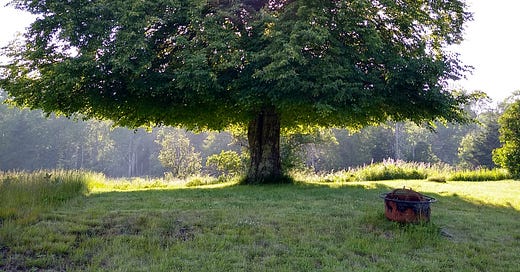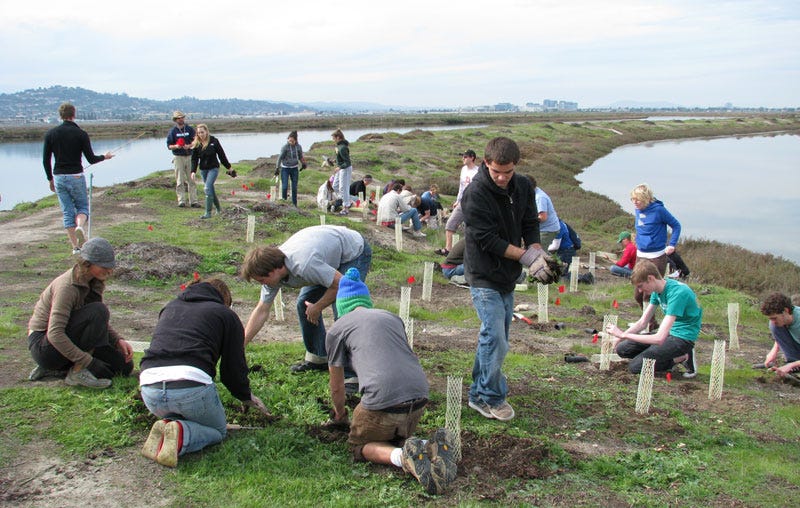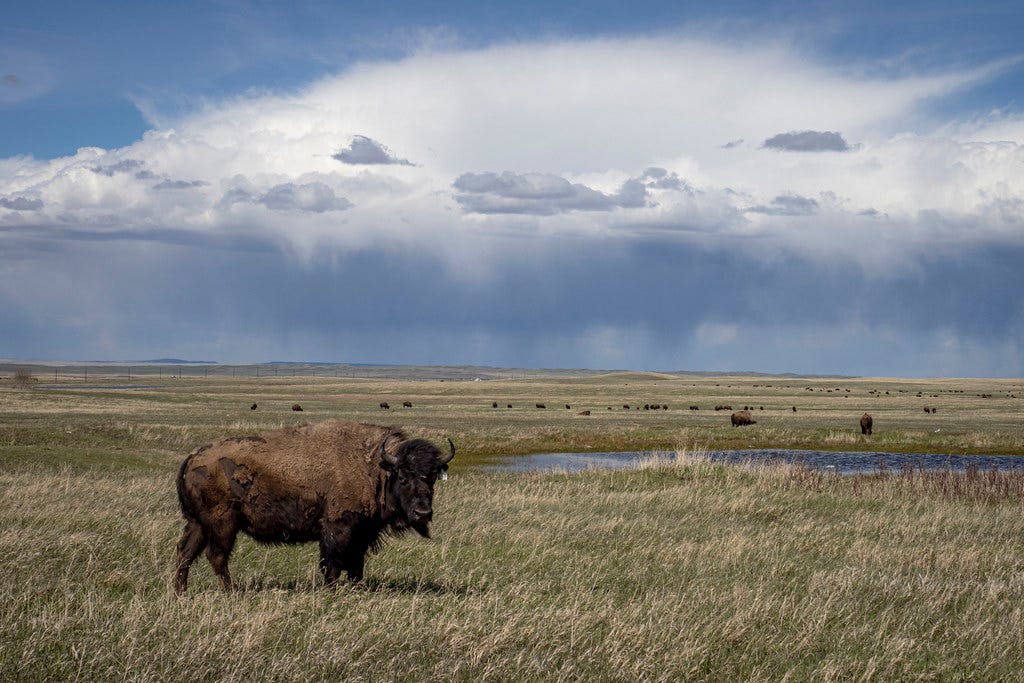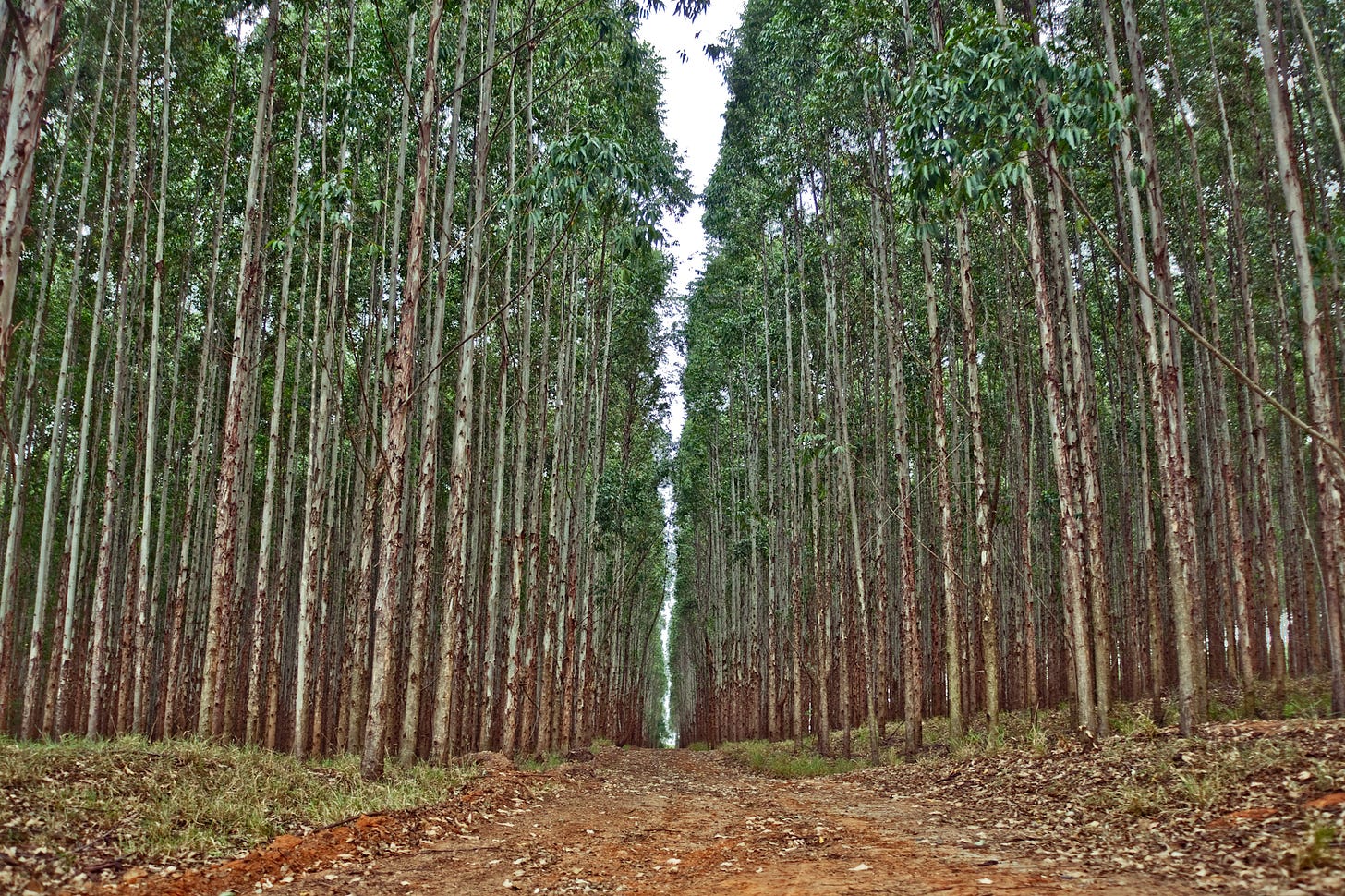A Flat Tire and a Dead Battery, Part 2
7/28/22 – The way forward is to approach both the biodiversity and climate crises
Hello everyone:
Heather and I are away this week, back on the island. We’re extraordinarily fortunate that our friends Anne and Josh have gifted us their cottage for the week. This trip is a vacation, not a crazy paint job. Enjoy the completion of this brief introduction to the necessity of dealing with both global crises at once. This week’s writing is a bit more cheerful, as is the focus on good news in the curated news section. Enjoy!
As always, please remember to scroll past the end of the post to read this week’s curated Anthropocene news.
Now on to this week’s writing:
Let me start by repeating, with some edits, the closing of last week’s writing:
For the ultimate source on understanding the way forward in solving both the biodiversity and climate crises at the same time, take a look at the 2021 report from the joint session of the IPBES (The Intergovernmental Science-Policy Platform on Biodiversity and Ecosystem Services) and the IPCC (Intergovernmental Panel on Climate Change) which focused on the intersection of climate and biodiversity. This is the scientific epicenter of the shift in focus to a two-pronged approach to mending the Anthropocene.
So, yes, we do have to tackle all of this at once. “It is clear that we cannot solve [the global biodiversity and climate crises] in isolation – we either solve both or we solve neither,” says Norway’s climate and environment minister.
The good news is that there are so many ways to move the needle on both at the same time that we can all get busy helping right now.
First and foremost, reduce greenhouse gas emissions as quickly as possible. Get rid of your SUV. Do all you can personally to reduce fossil fuel use, and as a citizen/activist to push policy in the right direction. Elect only climate-focused candidates locally and nationally. Reduced emissions means reduced harm to the array of life that sustains us.
Eat less meat and dairy – even organic – and wherever possible support sustainable farming practices. I was surprised to learn that organic meat production is just as bad for the climate as conventional meat production, but not surprised that “the lowest impact meat was still far more damaging than the worst plant foods.” On the biodiversity front, animal agriculture is much, much harder on the Earth than farming plants, as this Guardian article makes clear:
“Animal agriculture not only emits 10 to 100 times more greenhouse gases per unit product than plant-based foods, they also use 10 to 100 times more land,” said Prof Pete Smith, of the University of Aberdeen. “So more plant-based diets would mean more environmentally friendly farming and then there would be more land on which to apply nature-based solutions.”
Insist that climate change be confronted primarily with nature-based solutions, which fall broadly into three categories: a) stopping further loss of those ecosystems that are especially rich in both species and carbon; b) protecting what intact ecosystems remain by expanding conservation areas; and c) restoring those habitats wherever we can. Considering how much habitat has been lost, there is tremendous opportunity for restoration and rewilding across the globe, probably even in your neighborhood.
Between 1970 and 2000, for example, the world lost 40% of mangrove forests and 60% of salt marshes. These ecosystems, like kelp forests and grasslands and tropical forests, can be largely restored if we put in the time and effort. There are people ready to guide us, or to use our funds to do the work. Anyone interested in kelp forest restoration, for instance, can check in with the Kelp Forest Alliance information hub. Scientists and activists have been figuring out restoration strategies for years now, as this researcher notes:
The science of restoration of ecosystems has really blossomed over the last 40 years. We are now able to efficiently and effectively restore complex systems, tropical rainforest, coastal wetlands, kelp forests and seagrass meadows, natural American prairie, and UK meadows back to their near historical diversity.
You probably don’t have salt marshes or mangroves in your neighborhood, but any conservation group in your area looking to set aside more land for conservation is looking for your help, in whatever way you can provide it. These local efforts are essential to keep us engaged with protecting natural communities around us, and they’re essential for the most ambitious of conservation goals: 30x30, what the Campaign for Nature calls “the ambitious, science-driven, global goal to protect at least 30% of the planet by 2030.” (E.O. Wilson’s legacy Half-Earth Project is more ambitious, but that’s a story for another day.)
The last piece of the nature-based solution puzzle is the need to work directly with indigenous peoples, to engage their leadership for long-term, landscape-scale protection of life on Earth. The Campaign for Nature, for example, insists that indigenous leadership be woven into the management plans it advocates for and funds. Protection of wild places feels like a burden or loss to a resource-driven society, but not to a culture of management rooted in the sacred and empathetic relation to place that indigenous groups have maintained despite the ravages of the Anthropocene.
The importance of indigenous leadership is a topic I’ll dive into someday, especially since we’re seeing some wonderful indigenous-led conservation projects happening around the world. For more information now, though, you should read this eye-opening Vox article (“Indigenous people are the world’s biggest conservationists, but they rarely get credit for it”) or you can get wonky with the International Indigenous Forum on Biodiversity.
If you’d like to read up on a great and hopeful project that obligates an entire nation to respect the rights of nature and take on the challenges of ecological destruction and climate change, read about the new draft of the Chilean constitution. It faces an uncertain future before voters in September, but as an ethical and rational Anthropocene document it has no real comparison.
Global society is slowly coming around to the idea that we need to assess all of our actions in accordance with their impact on climate. Sadly, that’s become a bit of a problem on the biodiversity front. Because climate is only part of the havoc we’re wreaking, we need to be looking at our actions, including our climate actions, in terms of their impacts on the long-term survival of life itself. “We actually need to see every human endeavor, if you will, through the lens of biodiversity and nature,” one scientist at the U.N. Biodiversity Conference told the Times. “Since everyone depends on nature, she noted, ‘everyone is part of the solution.’”
We need to be clear on the solutions. Protecting ecosystems is about protecting them from us and our ecological amnesia. Planting a monoculture of trees without regard for habitat or natural history or the local human communities is a recipe for failure for both climate and life. Sterile groves of eucalyptus or pine trees doomed for the marketplace support very little of the life they have displaced. Native species must be planted where native species once grew, not simply on some real estate that’s convenient. Hasty “green” solutions to the climate crisis are cropping up everywhere, and have sometimes been just as destructive to biodiversity as a parking lot, like this project in Brazil:
In Brazil, parts of the Cerrado, a biodiverse savanna that stores large amounts of carbon, have been planted with monocultures of eucalyptus and pine in an attempt to meet a global reforestation goal. The result, researchers have written separately, is an “impending ecological disaster” because they destroy the native ecosystem and the livelihoods of local communities, including Indigenous people.
We need to replant forests, not trees. The goal, after all, is to rebuild resilient and diverse plant and animal communities which store carbon for the long haul. When a credit card company tells you they’ll “plant a tree” for you every time you buy something, be aware that that tree may not be a solution at all. The dilemma is in the details.
“Some people are out there selling this message that if we cover the whole planet with trees, that will solve the climate problem,” a scientist told the Times. “That’s a mistaken message on many levels.”
Another key obstacle right now is a bias in policy and funding that favors construction and engineering projects over nature-based solutions. A good article by Fred Pearce in Yale e360 a few months back took a good hard look at this, noting in frustration that, unlike technical projects, “nature-based adaptation can simultaneously help meet the three great challenges of our time: responding to climate change, protecting biodiversity, and ensuring human well-being.” But the discrepancy between funding priorities is disheartening:
Overall, the UN Environment Programme and the Global Commission on Adaptation, an international body set up by the Dutch government, both estimate that about 1 percent of total climate finance has so far gone toward such nature-based adaptation projects.
One percent of climate finance has gone to nature-based adaptation… That is a recipe for disaster. The good news is that there’s a lot more talk about shifting funding priorities toward solutions for both crises, but the money train hasn’t really shifted direction yet. The bias seems largely due to a) funders’ narrow-minded focus on climate and emissions reduction, and b) the perception that outcomes from technical solutions (seawalls vs. replanting mangrove forests) are more predictable.
You can see the Anthropocene bias toward technical solutions even in the title of this writing, in the metaphor of the flat tire and dead battery. Our language, like our culture, is so abstracted from the natural world that even the director of the Campaign for Nature looks to the fossil-fueled beasts we keep in our driveways for a metaphorical solution to the burning world. The world has been paved for our cars and trucks, the Earth has been brutally mined and drilled to build and fuel them, and now, as we seem to be driving recklessly toward a mass extinction, we have our metaphor of being stranded on the side of the highway.
One problem among many with the metaphor is its quiet assumption that a good samaritan or mechanic might come along to save the day. But we’re the only help that’s coming.
Maybe the solution, however, isn’t to fix the car but to make it obsolete.
Thanks for sticking with me.
In other Anthropocene (good) news:
From the Washington Post, the beautiful and important success story of bison herds repopulating the American plains with the support and activism of a network of tribes. Tens of millions of bison once roamed the plains, then were nearly driven extinct – only a few thousand remained – but now, a century later, hundreds of thousands are back on the landscape. The Post article does a nice job of explaining how, as a keystone species that once defined much of North America, the bison are rebuilding a whole array of ecological relationships with plants, insects, birds, and mammals wherever they go.
From The Ecological Citizen, an excellent interview with Sara Ines Lara of Women For Conservation, a nonprofit working to simultaneously improve human and ecological communities through empowerment of women around the world. Here’s a good clip from the interview:
It is because women especially want to leave a livable planet for their children that they are the largest untapped resource for sustainable futures. When women are empowered to have control over their bodies, they often choose to have less children who are then better nourished, better educated, have more opportunities and also put less strain on the natural environment. When women are offered environmental careers such as forest guards, bird guides, artisans and ecotourism hosts, they are passionate about doing work that will economically benefit their children, families and communities while also protecting the invaluable natural resources that can sustainably provide for their descendants to come.
From the Times, coal plants are shutting down and being replaced onsite with solar farms or other renewable projects, largely because they have one incredibly important resource already in place: plug-and-play access to heavy-duty transmission lines. It feels really good to read about this major transition taking place in our lifetimes.
Two Good Information Hubs:
Beyond Pesticides is a comprehensive site for understanding the harms from pesticides to people and habitats, and a great source for thinking differently about pesticide use. Want to know more about the links between pesticides and infertility, cancers, and biodiversity loss? Want to help them advocate to get plastics out of organic farming? It’s a tremendous resource well worth checking out.
From Project Drawdown, the best source available online for comprehensive climate solutions, a six-video series called Climate Solutions 101, “the world’s first major educational effort focused solely on solutions.”










